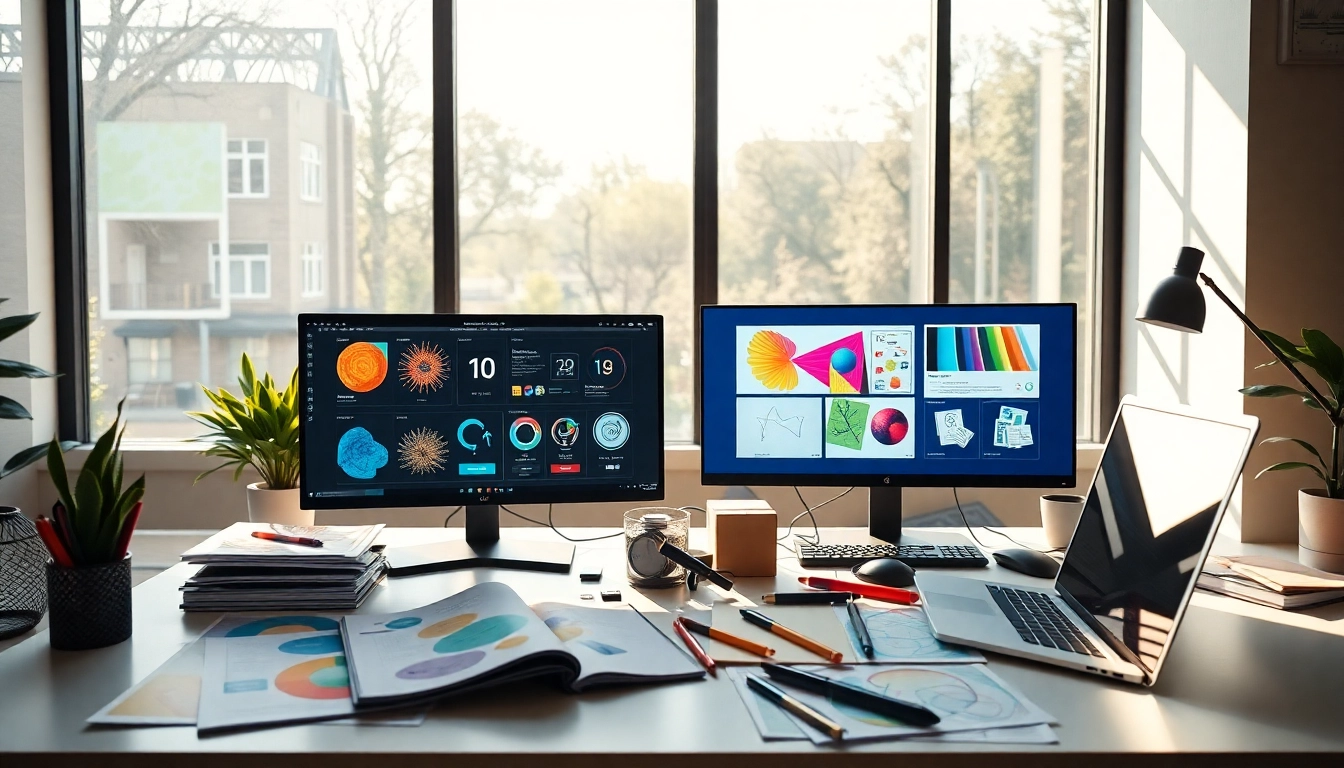
Enhancing Business Creativity: Leveraging AI Design Tools Effectively
Understanding AI Design Tools for Businesses
In today’s fast-paced digital environment, businesses are constantly seeking innovative ways to enhance their creativity, streamline processes, and reduce costs. Enter AI design tools—powerful software applications leveraged by companies to automate the design process, boost productivity, and foster creativity. Companies of all sizes are discovering the potential of AI design tools for businesses to revolutionize their operations. This article aims to provide a comprehensive overview of AI design tools, their benefits, popular options available, implementation strategies, and what the future holds for these technologies.
What Are AI Design Tools?
AI design tools are software applications that utilize artificial intelligence and machine learning algorithms to assist creators—from graphic designers to marketers—in developing visual content efficiently. These tools range from simple applications that enhance images to complex systems that can create entire websites or marketing campaigns based on minimal input from users.
The functionality of AI design tools often includes features such as automatic image generation, template creation based on user specifications, layout suggestions, and even the ability to learn from user interactions to improve results over time. Popular examples include Canva’s Magic Design, Designs.ai, and Adobe Sensei, among others.
The Importance of AI in Modern Business
The integration of AI into business practices has become fundamental as organizations maneuver in a competitive landscape where agility and efficiency are paramount. The ability to leverage AI tools effectively allows businesses to:
- Reduce production times and increase output.
- Enhance design quality through advanced algorithms.
- Optimize customer experiences with personalized content.
- Allocate resources more strategically, enabling teams to focus on higher-level tasks.
Notably, companies embracing AI technologies are witnessing transformative shifts in both operational processes and creative outcomes, leading to innovative solutions that resonate with their audience.
Common Features of AI Design Tools
When exploring the landscape of AI design tools, there are several common features that many programs share. These include:
- Template Generation: Many AI design tools boast vast libraries of templates for various needs, allowing users to select a base that aligns with their vision quickly.
- Image and Video Generation: Tools like Designs.ai can automatically generate logos, videos, and social media graphics, simplifying the creation process.
- Customization Options: Users can often tweak designs extensively, from colors to layouts, ensuring the end product meets their unique specifications.
- Collaboration Features: Designed for teams, many tools enable multiple users to collaborate in real-time, streamlining the feedback process and enhancing teamwork.
- Machine Learning: As users interact with these tools, they often learn user preferences, enabling personalized suggestions that improve over time.
Benefits of Using AI Design Tools
Streamlining Design Processes
One of the primary advantages of AI design tools is their ability to streamline workflows. By automating mundane tasks such as resizing images or generating variations of designs, teams can focus on higher-level strategic decisions that drive creative directions. These tools often reduce the time from concept to completion, effectively increasing productivity.
Enhancing Creativity and Innovation
AI design tools enable businesses to explore new creative avenues by offering suggestions and options that a human designer might not initially consider. With features like generative design and predictive analytics, these applications can surprise teams with innovative layouts or unique design concepts based on existing data.
Cost-Effectiveness for Small Businesses
For small businesses and startups, budget constraints can limit access to professional design services. AI design tools offer a cost-effective alternative, providing professional-grade design capabilities without the need for hiring full-time designers. This affordability, combined with ease-of-use, makes these tools an attractive option for smaller organizations looking to enhance their marketing materials and overall branding.
Popular AI Design Tools for Businesses
Top Tools Reviewed
Several AI design tools are gaining traction among businesses. Here are a few notable mentions:
- Canva Magic Design: This user-friendly tool offers various templates and a simple drag-and-drop interface, ideal for non-designers.
- Designs.ai: Known for its all-in-one capabilities, it allows users to create logos, videos, and graphics using AI-driven algorithms.
- Adobe Spark: A robust platform that integrates with Adobe’s suite of products, Spark enables quick creation of visuals with professional flair.
- Looka: An AI logo maker that helps businesses design their branding with ease, offering a range of design ideas based on user input.
Comparison of Features and Pricing
When selecting the most suitable AI design tool, it’s essential to compare the features and pricing structures. Most tools generally operate on a subscription basis, with tiers available to accommodate different business needs. For instance:
- Canva offers a free version with limited features, while its Pro version unlocks advanced functionalities.
- Designs.ai operates on an affordable subscription model, offering project-based pricing.
- Adobe Spark provides various plans, including a free version catering to basic needs, but with limited project exports.
By assessing each tool’s features alongside its pricing, businesses can make informed decisions that balance budget constraints with their graphic design needs.
User Testimonials and Case Studies
Real-world applications of AI design tools underscore their effectiveness:
One business, a local coffee shop, successfully grew its brand presence through Canva’s user-friendly interface. Within weeks, they had transformed their social media presence and marketing materials, leading to a 30% increase in customer engagement.
Another example is Cryptocade, a startup in the cryptocurrency space, that leveraged Designs.ai to create a full branding suite within hours, reducing their pre-launch marketing budget by over 50%.
These case studies highlight that AI design tools not only foster creativity but can also deliver tangible business results.
Implementing AI Design Tools in Your Business
Steps to Integrate AI Tools into Workflows
Implementing AI design tools into existing workflows requires a well-organized strategy:
- Assessment: Evaluate your current design processes and identify pain points that AI tools can address.
- Choose the Right Tool: Based on your assessment, select an AI design tool that best fits your needs and budget.
- Elicit Team Feedback: Involve your design team early in the decision-making process to gather insights and foster buy-in.
- Implement Gradually: Start with one project or department to evaluate effectiveness before a broader rollout.
Training Your Team on New Technologies
To maximize the benefits of AI design tools, team training is essential. Here are some best practices:
- Hands-On Workshops: Conduct workshops where team members can explore and practice using the new tools.
- Documentation and Resources: Provide resources, such as user guides and tutorials, to assist team members in their learning process.
- Encourage Experimentation: Allow team members to experiment within the tool to discover its full potential without fear of making mistakes.
Measuring Success and ROI
Establishing metrics to gauge the success of AI design tool implementation is crucial. Consider the following:
- Time Savings: Measure how much time is saved in design processes.
- Cost Savings: Track reductions in design or marketing expenses due to efficiencies provided by the tools.
- Engagement Metrics: Analyze engagement statistics on content created with AI tools to gauge effectiveness and refinement.
Regularly analyzing these metrics will provide insights into how AI tools are performing and where further adjustments may be necessary.
The Future of AI in Design
Predictions for Upcoming Trends
As AI technology continues to evolve, several trends are emerging in the design landscape:
- Conversational Design Tools: Future AI tools may offer conversational interfaces where users can create their designs through voice or chat commands.
- Augmented Reality (AR) Applications: AI is expected to greatly enhance AR in design, allowing users to visualize their digital designs in real-world scenarios.
- Increased Personalization: AI’s capability to analyze user behavior will lead to more tailored designs and user experiences.
The Role of AI in Sustainable Design
Sustainability is rapidly becoming a key concern in design. AI can play a crucial role in promoting sustainable design practices by:
- Optimizing carbon footprints through efficient production processes.
- Reducing waste in design iterations by refining outputs based on user feedback.
- Generating designs that prioritize eco-friendly materials or production methodologies.
By embedding sustainability into design processes, businesses can align with global movements toward environmental responsibility.
How Businesses Can Stay Ahead of the Curve
To maintain a competitive edge, businesses must continuously monitor advancements in AI design tools. Here are some strategies:
- Continuous Learning: Encourage teams to stay informed through online courses, webinars, and industry conferences focused on emerging AI technologies.
- Feedback Loops: Regularly solicit customer feedback on designs to evolve with market demands and preferences.
- Innovation Culture: Promote a culture of experimentation where teams feel empowered to explore new tools and methods in their design processes.
By proactively engaging with emerging trends and feedback, businesses can adapt swiftly to a constantly evolving design landscape driven by AI advancements.



